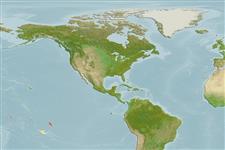Teleostei (teleosts) >
Gobiiformes (Gobies) >
Gobiidae (Gobies) > Gobiinae
Etymology: Eviota: No etymology given, suggested by Christopher Scharpt: from Latin 'eu' for 'true' and 'iota' for anything very small, in combination 'truly very small' referring to it as being the smallest vertebrate at the time it has benn described by Jenkins (thus, making the suggestion by Scharpt plausible; deminuta: Name from Latin adjective 'deminuta' meaning small, diminutive. Both scientific and common names refer to the tiny size and reduced morphology of this species; noun in apposition.
Environment: milieu / climate zone / depth range / distribution range
Ecology
Marine; reef-associated; depth range 2 - 41 m (Ref. 94084), usually 3 - 6 m (Ref. 94084). Tropical
Eastern Central Pacific: Marquesas Islands, French Polynesia (widely distributed among the islands of the Archipelago).
Size / Weight / Age
Maturity: Lm ? range ? - ? cm
Max length : 0.9 cm SL male/unsexed; (Ref. 94084)
Short description
Identification keys | Morphology | Morphometrics
Dorsal spines (total): 7; Dorsal soft rays (total): 8 - 9; Anal spines: 1; Anal soft rays: 7 - 8. This species is distinguished by the following set of characters: no sensory pores on head; dorsal/anal formula 8/7; branched pectoral-fin rays; fifth pelvic-fin ray absent; caudal peduncle has a dark spot, typically restricted to above lateral midline; caudal peduncle with a dark blotch over the middle, and a dark bar or crescent over its posterior margin and base of caudal rays (Ref. 94084).
Collected from coral and rocky reefs at depths from 3-41 m; very abundant at Nuku Hiva, where nearly 250 individuals were captured in a single collection between 3-6 m depth (Ref. 94084).
Life cycle and mating behavior
Maturity | Reproduction | Spawning | Eggs | Fecundity | Larvae
Tornabene, L., G.N. Ahmadia and J.T. Williams, 2013. Four new species of dwarfgobies (Teleostei: Gobiidae: Eviota) from the Austral, Gambier, Marquesas and Society Archipelagos, French Polynesia. Syst. Biodiver. 11(3):363-380. (Ref. 94084)
IUCN Red List Status (Ref. 130435: Version 2024-2)
Threat to humans
Harmless
Human uses
Tools
Special reports
Download XML
Internet sources
Estimates based on models
Preferred temperature (Ref.
123201): 27.7 - 28.1, mean 28 °C (based on 18 cells).
Phylogenetic diversity index (Ref.
82804): PD
50 = 0.5000 [Uniqueness, from 0.5 = low to 2.0 = high].
Bayesian length-weight: a=0.00692 (0.00284 - 0.01683), b=3.10 (2.92 - 3.28), in cm total length, based on LWR estimates for this Genus-body shape (Ref.
93245).
Trophic level (Ref.
69278): 2.9 ±0.3 se; based on size and trophs of closest relatives
Resilience (Ref.
120179): High, minimum population doubling time less than 15 months (Preliminary K or Fecundity.).
Fishing Vulnerability (Ref.
59153): Low vulnerability (10 of 100).
